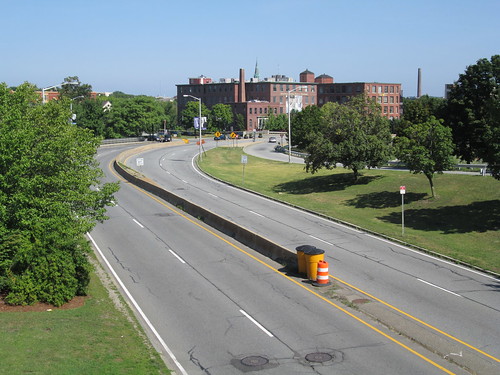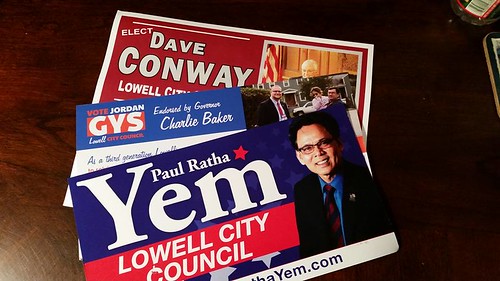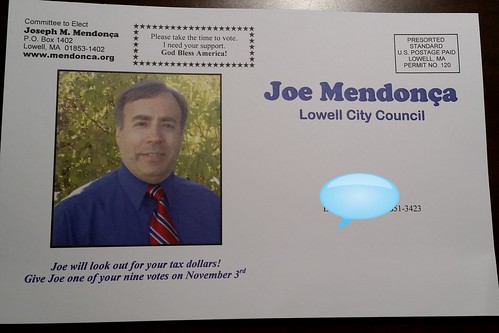Lowell Week in Review: October 25, 2015


Point Park, Hamilton Canal District
Hamilton Canal District
The big news at Tuesday’s City Council meeting was the announcement by City Manager Kevin Murphy that three developers responded to the city’s Request for Qualifications for the Hamilton Canal District. Watermark Environmental, which now is housed in the Wannalancit Mills, wants to build its corporate headquarters on a prime lot along Dutton Street. This new building would be five to seven stories tall with space for retail on the ground floor. The second proposal came from Genesis HealthCare, a national company that already operates two nursing homes in Lowell. Genesis would partner with UMass Lowell to build a 144,000 square facility that would include research space, treatment beds, and administrative offices. Finally, a consortium of Anchor Line Properties, which now owns Cross Point, and WinnCompanies, which now owns Boott Mills, proposed becoming the master developer for the entire project (although the city can carve out individual lots as it would for Watermark and Genesis).
In other Hamilton Canal news, the LRTA Advisory Board on Thursday voted to lease a parcel of land on YMCA Drive to the city to be used for the parking of tour buses that are visiting Lowell National Historical Park. Those buses now park in the NPS’s Dutton Street lot. The city has for years been negotiating with the Department of the Interior (overseer of the National Park Service) to acquire that parking lot for development as part of the Hamilton Canal District. The US Government won’t sell the land outright, but requires a trade of like value. One of the values of the existing surface lot is the parking provided for Park visitors. The city plans to construct a new multistory parking garage nearby and use the current surface lot for building development. Visitors to the National Park will use that new garage. Bus parking proved to be the sticking point. If the buses had to park in the garage, the garage would be designed to accommodate them with a high-ceilinged first floor. That would add to the cost of construction and would deprive the city of the ability to house retail establishments on the first floor of the garage, the rent from which would help pay the cost of construction. If the buses could park offsite, as they can now on the LRTA site, the garage can be constructed to accommodate cars only and can have retail rental space on the ground floor.
If you drive past the Hamilton Canal District these days, you will notice a frenzy of construction activity in the area adjacent to the Lord Overpass. This is the extension of Jackson Street. Eventually, Jackson Street is supposed to cross Dutton and connect to the end of Fletcher, but the work being done now will just extend Jackson Street far enough to allow construction vehicles to get to the site of the new judicial center. Construction on that cannot begin until the Jackson Street extension is at least partially completed. I understand that the final design of the Judicial Center is near completion and that construction is supposed to begin in the spring.

Thorndike St seen from Lord Overpass
If you are interested in learning more about the Hamilton Canal District, please join us next Saturday, October 31, 2015 at 10 am at Lowell National Park Visitor Center, 246 Market Street, for a Lord Overpass Walk. Paul Marion and I will lead this 90 minute walk which will go from the Visitor Center, through the Hamilton Canal District, up and over the Lord Overpass and on to the South Common. There, we will cross Thorndike Street to the Gallagher Terminal and then come back along the other side of Thorndike and Dutton, stopping at all the important sites along the way. How this area, particularly the Lord Overpass reconstruction, is strategically integrated with the Hamilton Canal District is critical to the success of the Hamilton Canal District process. The risk is that the professionals will be so focused on the build-out of the Hamilton Canal District, that they will forget how all of these other pieces fit into the big picture and opportunities will be lost. This walk is intended to raise awareness of all of these other pieces and to get anyone who is interested out on the ground, viewing the sites up close and personally.
Panhandling Ordinance Struck Down
Frustrating is how many elected official described the recent ruling by U.S. District Court Judge Douglas Woodlock that invalidated the city’s “aggressive panhandling” ban for downtown. I wouldn’t call it frustrating; I would call it predictable. I wish people didn’t have to panhandle (or for some, choose to panhandle) but they have the right to do it and efforts to outlaw it are not only destined to fail but they also distract us from strategies that might work better.
One of the reasons panhandlers stand out so much in downtown Lowell is that there are so few other people walking around downtown. To say the panhandlers drive them out is inaccurate because these other people just aren’t there in the first place. We spend a lot of time searching for the home run of drawing hordes of out-of-town visitors or conventions, but what would those visitors find when they get here? Panhandlers. What we really need is a lot more local people wandering around downtown on a daily basis, especially on weekends. Lowell has 105,000 residents and our contiguous towns have another 200,000. If you could just get 1% of the people in Lowell to come downtown on Saturdays, that would be 1000 people. Even if they didn’t spend any money, having 1000 people walking around the streets of Lowell would enliven the place. The panhandlers would fade into this great shuffle and would barely be noticed.
Another strategy might be to divert the cash now being given to those who ask for it on downtown streets and highway exit ramps to agencies and nonprofits that provide services to the homeless. Why doesn’t the city hold a contest with a big cash prize for someone to build a cell phone app that would allow donors to instantaneously transfer small dollar amounts into a central “homeless assistance fund” that could be administered by the city’s existing Hunger Homeless Commission. With such a system in place, when someone asks you for spare change, you could just pull out your phone and with a couple of taps, make your donation online. By publicizing that as a way of giving, it might divert some of the cash now being given to individuals on the street to entities that directly address homelessness.
Whatever the response to this latest court action, let’s not double down on a punitive ordinance. It’s a waste of time and diverts us from strategies more likely to succeed.
Council Election News
With the city election just nine days away, candidate activity is picking up. When I received three candidate mailers on Thursday (Jordan Gys, Dave Conway, and Paul Ratha Yem), I posted a picture on Facebook and Twitter and asked everyone else to do the same as a way of tracking who is using direct mail as a campaign tactic. But Friday brought nothing and yesterday brought just one (Joe Mendonca). If you’re a voter in Lowell, please consider posting photos of the pieces you receive on social media. That candidates, at least, will appreciate it.


In every local election there are a number of subplots that play out. Here are a few I’ve identified:
Comebacks: Joe Mendonca and Vesna Nuon, two sitting councilors who lost their seats in the 2013 election are mounting comeback attempts. Others who have tried this have been successful (Jim Milinazzo); others have not (Armand Mercier). Will Joe and Vesna succeed?
Jump from School Committee: Two sitting school committee members, Jim Leary and Dave Conway, are running for the city council this year. Historically that has been a tough transition to make, at least on the first attempt. In recent memory, John Leahy and Joe Mendonca both failed in their first attempts to go from the school committee to the city council, yet both did attain council seats shortly thereafter through vacancies or subsequent runs.
School Committee Election: I never remember an election in which two-thirds of the incumbents chose not to seek reelection so in that respect, this year’s school committee race is an historic one. With only two incumbents (Steve Gendron and Connie Martin), a minimum of four newcomers will be elected. With memories of the recent superintendent selection process and unrest over contract negotiations in the air, many voters might have the school committee race foremost in their minds when they go to the polls. How that affects the council race is unknown, although Jim Leary, Dave Conway, and Mayor Rodney Elliott would be the council candidates most likely to be affected.
The Cambodian Vote: When I last checked, there were approximately 11,000 registered voters in Lowell with Southeast Asian surnames. That is approximately 20% of all the registered voters in the city. With six Cambodian candidates on the ballot in this election (Cheth Khim, Vesna Nuon, Pan So, and Paul Ratha Yem for council; Kamara Kay and Dominik Lay for school committee), will there be a greater turnout of Southeast Asian surnamed voters in this year’s election than in past years? In a race in which a hundred votes might be the difference between sixth place and tenth place, that could be decisive. With last year’s election of Rady Mom to the 18th Middlesex District State Representative seat, perhaps this block of voters might better realize their potential power at the ballot box and turn out in greater numbers this year.
The Belvidere Effect: Most of the incumbent councilors live in the Belvidere neighborhood which is no coincidence since most of those who vote in city elections live in Belvidere. Will this motivate people who live in the rest of the city’s neighborhoods to go to the polls in higher numbers and support candidates who live in their vicinity? Probably not, if history is our guide, but you never know.
The power of incumbency: Eight incumbent city councilors seek reelection the Tuesday after next. How likely is it that an incumbent will lose? It’s impossible to know, of course, but we can look to history as a guide. Here’s a look at some recent city elections:
2013: Incumbents Marty Lorrey, Joe Mendonca, and Vesna Nuon all lost. Patrick Murphy did not seek reelection. They were replaced by Corey Belanger, Dan Rourke, Bill Samaras, and Jim Milinazzo.
2011: Incumbent Jim Milinazzo lost. Franky Descoteaux and Bud Caulfield did not seek reelection. They were replaced by Marty Lorrey, Vesna Nuon, and Ed Kennedy.
2009: Incumbents Armand Mercier and Alan Kazanjian lost and Mike Lenzi did not seek reelection. They were replaced by Franky Descoteaux, Joe Mendonca, and Patrick Murphy.
2007: Eileen Donoghue did not seek reelection. Incumbent George Ramirez resigned from the council shortly before the election and was replaced by Joe Mendonca. Technically, an incumbent, Mendonca did not win reelection in 2007. All other incumbents running did. Alan Kazanjian and Mike Lenzi replaced Mendonca and Donoghue.
2005: All incumbents running were reelected. Richard Howe did not seek reelection. He was replaced by George Ramirez.
2003: All incumbents running were reelected. Dan Tenczar did not seek reelection. He was replaced by Jim Milinazzo
2001: All incumbents were reelected.
1999: Incumbents Grady Mulligan and Larry Martin lost. Peter Richards did not seek reelection. They were replaced by Dan Tenczar, Bill Martin, and Rithy Uong.
For past Lowell election results, check out our Election Results and Candidate Biographies page.
Lowell Walks Retrospective
Finally, don’t forget that tomorrow night (Monday, October 26, 2015) we’re holding our Lowell Walks Retrospective Meeting at the Pollard Memorial Library’s ground floor community room at 6:30 pm. We will review our successful Lowell Walks from this past summer, discuss the Walks lineup for next summer, and think about ways to make Lowell Walks a year-round venture. Everyone is invited. Just show up if you’re interested.
Speaking of the new HCD garage…Lowell Downtown Neighborhood Association meeting Monday, October 26th at 7PM at the LTC will have Craig Thomas from the City speak about the parking garage that will be built directly behind Canal Place and Market Mills in the empty parking lot the City currently uses for snow removal.
The mailer from Dave Conway reads: “The present traffic plan is not working. We need to go back to the table and review the changes that were made in city traffic patterns and GET IT RIGHT.”
This is code for getting rid of two-way traffic and reverting back to one-way streets. This is a horrible idea. The consensus downtown is that two-way traffic is better than one-way. Study after study proves that two-way is better for business, walkability, visitors, safety, and congestion.
The problem is that congestion is worse in Lowell because more cars are on our streets and nobody knows what to do about it. The fairytale solution is that we synchronize the lights, widen a street, or build a new Rourke bidge.
A visionary plan would focus on reducing the amount of cars on our streets. This can be done by increasing walkability, adding protected bike lanes, improving bus transit, and changing zoning etc. so that more small businesses are in the neighborhoods thus reducing intracity trips.
Where are the visionary candidates?
Brian, I agree with you completely. Another contributor to traffic congestion are parents driving their children to or from school or to the bus stop. High school students should also be discouraged from driving to school. Better bus service and better bicycle and pedestrian amenities would help here. All of the schools provide very few bicycle amenities. I see the lack of student walkers as a chicken and the egg type problem. Many parents are reluctant to let the children walk, sometimes even to the bus stop, out of fear of accidents; this means that they are then contributing to the auto traffic congestion. As a teacher, I see parents queued up in their cars at schools and bus stops.
Good points Paul. I think bringing middle schools to Lowell in the 90’s discourages kids from walking to school. Whereas a 5th or 6th grader could have been trusted walking a 1st grader to school in the past when schools were k-6 you would now have to rely on a 3rd or 4th grader walking a 1st grader to school. I’m not sure parents are comfortable with this.
To this point I don’t think some parents are comfortable with 5th graders mixing with “certain” 8th graders so they feel safer sending them to private schools. Opening up the middle schools also meant closing many neighborhood schools where kids mostly walked to school. Economies of scale!
The Reilly school doesn’t even have sidewalks on many of the streets adjacent to the school. A system wide effort to get more kids to walk and bike to school is a great idea. I can’t imagine teachers like having to direct traffic and help kids get out of their parents cars in the morning.